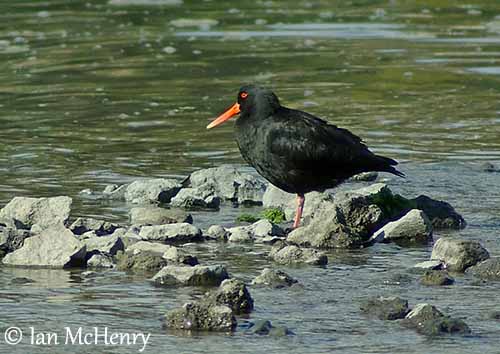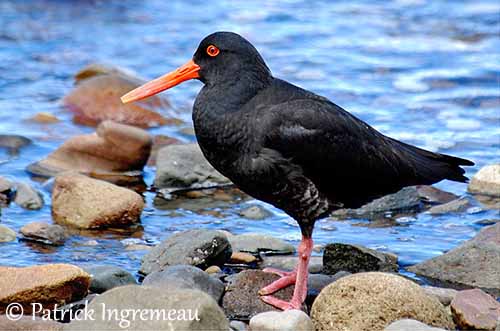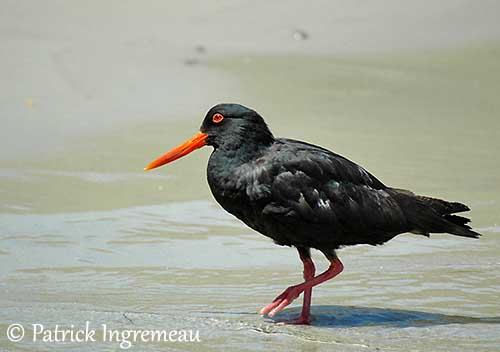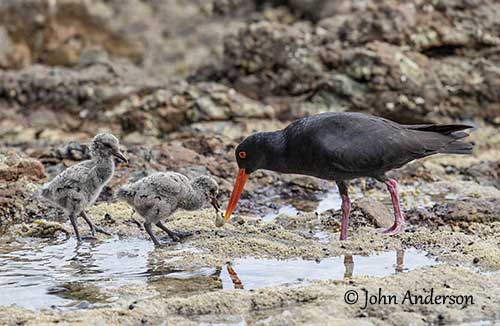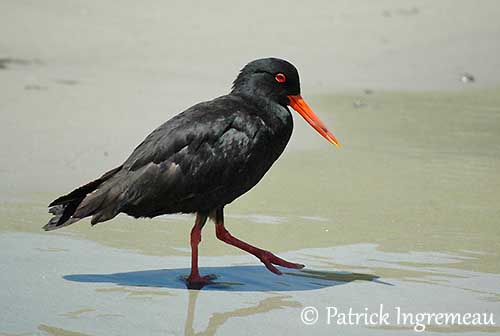
Fr: Huîtrier variable
Maori: Torea, Toreapango
Ang: Variable Oystercatcher
All: Neuseeländischer Austernfischer
Esp: Ostrero Variable
Ita: Beccaccia di mare variabile
Nd: Nieuw-Zeelandse Zwarte Scholekster
Sd: Nya Zeelandstrandskata
Photographers:
John Anderson
John Anderson Photo Galleries
Ken Havard
My Bird Gallery & Flickr gallery 1 & Flickr gallery 2
Patrick Ingremeau
TAMANDUA
Ian McHenry
My New Zealand Birds
David Nowell
GALLERY
Otto Plantema
Trips around the world
Text by Nicole Bouglouan
Sources:
HANDBOOK OF THE BIRDS OF THE WORLD Vol 3 by Josep del Hoyo-Andrew Elliott-Jordi Sargatal - Lynx Edicions - ISBN : 8487334202
KNOW YOUR NEW ZEALAND BIRDS by Lynnette Moon - New Holland Publishers – ISBN: 1869660897
SHOREBIRDS by Peter Hayman, John Marchant and Tony Prater – Christopher Helm – 1986 – ISBN: 0747014035
BirdLife International (BirdLife International)
New Zealand bird status between 2008 and 2012
Te Ara – The Encyclopedia of New Zealand
New Zealand birds and birding (Narena Olliver)
Wikipedia, the free encyclopaedia
Variable Oystercatcher
Haematopus unicolor
Charadriiformes Order – Haematopodidae Family
INTRODUCTION:
The Variable Oystercatcher or Toreapango in Maori is endemic to New Zealand. The name “variable” derives from the different morphs of plumages, pied or black, with some intermediate forms between them. The colour morphs differ according to the range in the country. The black morph occurs mainly in the South and Stewart Island, and the pied morph is mainly found in the North of New Zealand.
The different morphs may interbreed and are accepted as a single species.
DESCRIPTION OF THE BIRD:
Biometrics:
Length: 48 cm
Weight: 720 g
All adults have black upperparts and head with greenish gloss, red to red-orange bare parts and pink legs and feet.
The black form is black overall with red bill and eyes, red-orange eyering and pink legs and feet.

The pied morph has white underparts including lower breast, belly, vent and undertail-coverts, with a few blackish feathers. This one lacks the white shoulder patch of other pied oystercatchers, but it has white wingbars. Back and rump are blackish, but the uppertail-coverts are white with some black-tipped feathers.
The intermediate form ranges between the two previous. It is black overall with black-and-white underparts. There are usually white streaks and spots on the black plumage. This form is larger, longer-billed and longer-winged than other morphs.
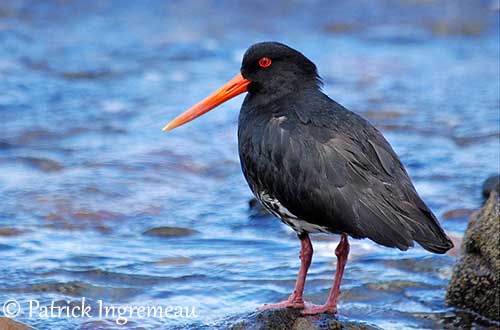
Both sexes have similar plumage, although two different forms may interbreed. The female is larger and longer-billed than the male.
The juvenile is browner than adults and the bare parts are duller. Scapulars and upperwing-coverts show some pale buff-tipped feathers.
RANGE:
The Variable Oystercatcher is found around the coastline of North, South and Stewart Islands and their offshore islands.
The higher densities occur in Northland, Auckland, Coromandel Peninsula, Bay of Plenty, Greater Wellington, Nelson/Marlborough, and probably Fiordland.
They are less numerous on the west coasts of North and South Islands.
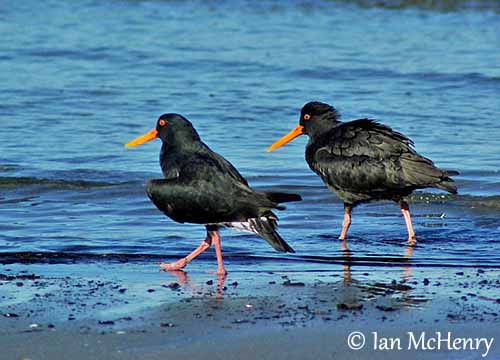
HABITAT:
The Variable Oystercatcher breeds usually on sandy beaches and coastal dunes. It frequents a wide variety of coastal habitats where it forages, such as rocky shorelines, sometimes gravel beaches, intertidal mudflats in estuaries and rocky platforms.
This species usually remains in the vicinity of the coast. However, it may occasionally nest inland on short grassy areas or bare ground, but only a short distance inland.
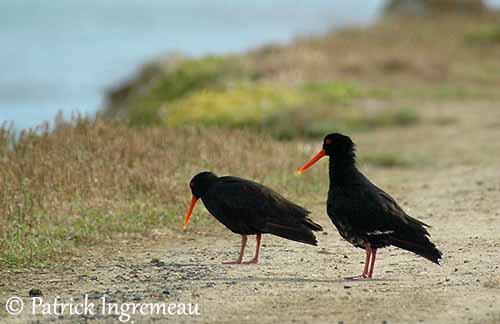
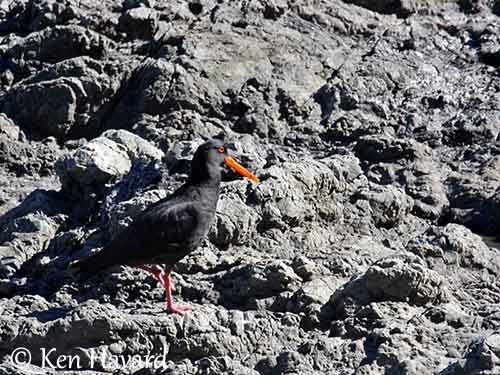
CALLS AND SONGS: SOUNDS BY XENO-CANTO
The Variable Oystercatcher gives loud piping “hu-eep” when alarmed and in territorial defence. In flight, it utters a “kleep” call. If the chicks are threatened, the adults give loud “chip” or “click” to warn them.
BEHAVIOUR IN THE WILD:
The Variable Oystercatcher feeds by picking food items from the surface, and by probing in shallow water, sand or mud with its long bill.
It feeds on marine worms, molluscs (especially bivalve molluscs when available), crabs and other crustaceans, and annelids. It may occasionally take small fish. It also catches insects, grubs and worms in coastal farmland.
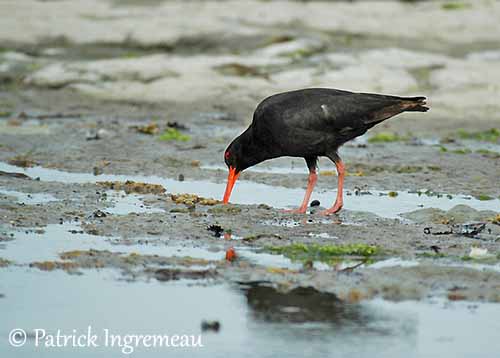
In order to open the bivalve molluscs, the Variable Oystercatcher only takes those that are themselves feeding because the valves are gaping. With its long bill, the bird stabs between the margins of the valves and severs the muscle.
It also smashes open mussel shells for the flesh, or hammers a hole in the shell of oysters. This technique has given these birds their name.
The foraging methods are learnt by the newly-independent young birds.
The Variable Oystercatcher is often seen in pairs, although during winter, they gather in flocks of up to 50 individuals or more.
The pairs are monogamous. The territory is strongly defended against neighbours and intruders. Numerous pairs remain all year round on their territory, and they have long-term, strong pair-bonds. However, other oystercatchers join flocks in large estuaries.
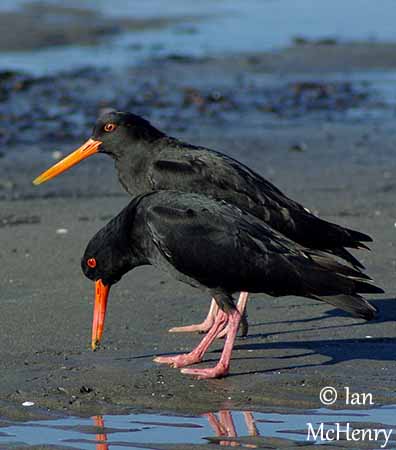
During the breeding season, they perform courtship displays such as “piping-dances”. The birds bow the head and run with quick, short steps. This display may involve two or three birds, and is accompanied by high-pitched rising trills, lowering slowly at the end of the display. They are very faithful to mate and site.
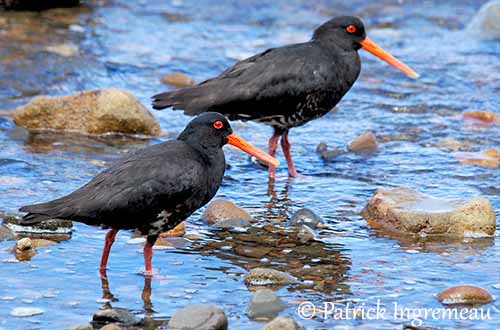
The Variable Oystercatcher is sedentary with some local movements when the flocks are forming.
The flight is strong and direct, thanks to the long, pointed wings.
REPRODUCTION OF THIS SPECIES:
The laying usually occurs between October and December, sometimes sooner, in early September.
The Variable Oystercatcher nests on rocky shores, sandy ridges near boulders, or under dune scrub. On Stewart Island, the nest is placed under overhanging rock or even in shallow caves.
The nest is a shallow scrape in the sand. It can be decorated with shells or twigs.
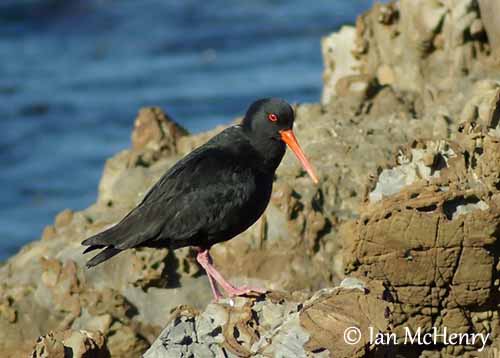
The female lays 2-3 eggs of cryptic colour, pale olive with blackish spots. Both adults share the incubation during 28 days. The downy chicks are pale brownish with black spots. They are able to leave the nest 2 days after hatching, but they remain within the territory where they are strongly protected and defended by their parents. They are fed by the adults while remaining under cover in rocks or vegetation. The chicks start to feed themselves while growing, but they are still fed by parents after fledging, about 6-7 weeks after hatching. They leave their native territory at 3 months old.
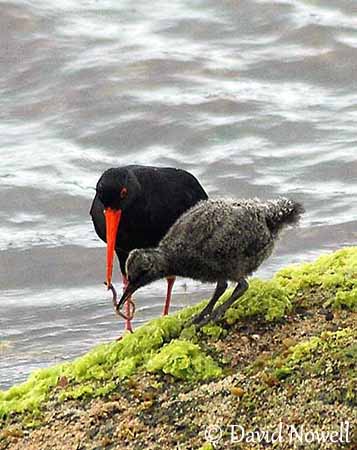
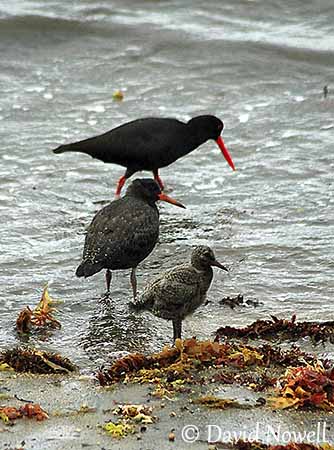
The parents become aggressive if humans come too close to the nest-site. They often dive-bomb, sometimes with contact, while calling loudly. Distraction displays are performed when defending eggs and chicks.
They may lay a second brood if the first clutch is lost.
PROTECTION / THREATS / STATUS:
The Variable Oystercatcher may be affected by predation by both avian and mammalian predators. Human disturbances at recreational sites and flooding of nest at very high tides are parts of the threats involving probably low breeding success.
The population is estimated at 4,000/4,300 mature individuals, and is suspected to be increasing, thanks to the protection of other shorebirds from which it has benefited.
The Variable Oystercatcher is currently evaluated as Least Concern.
